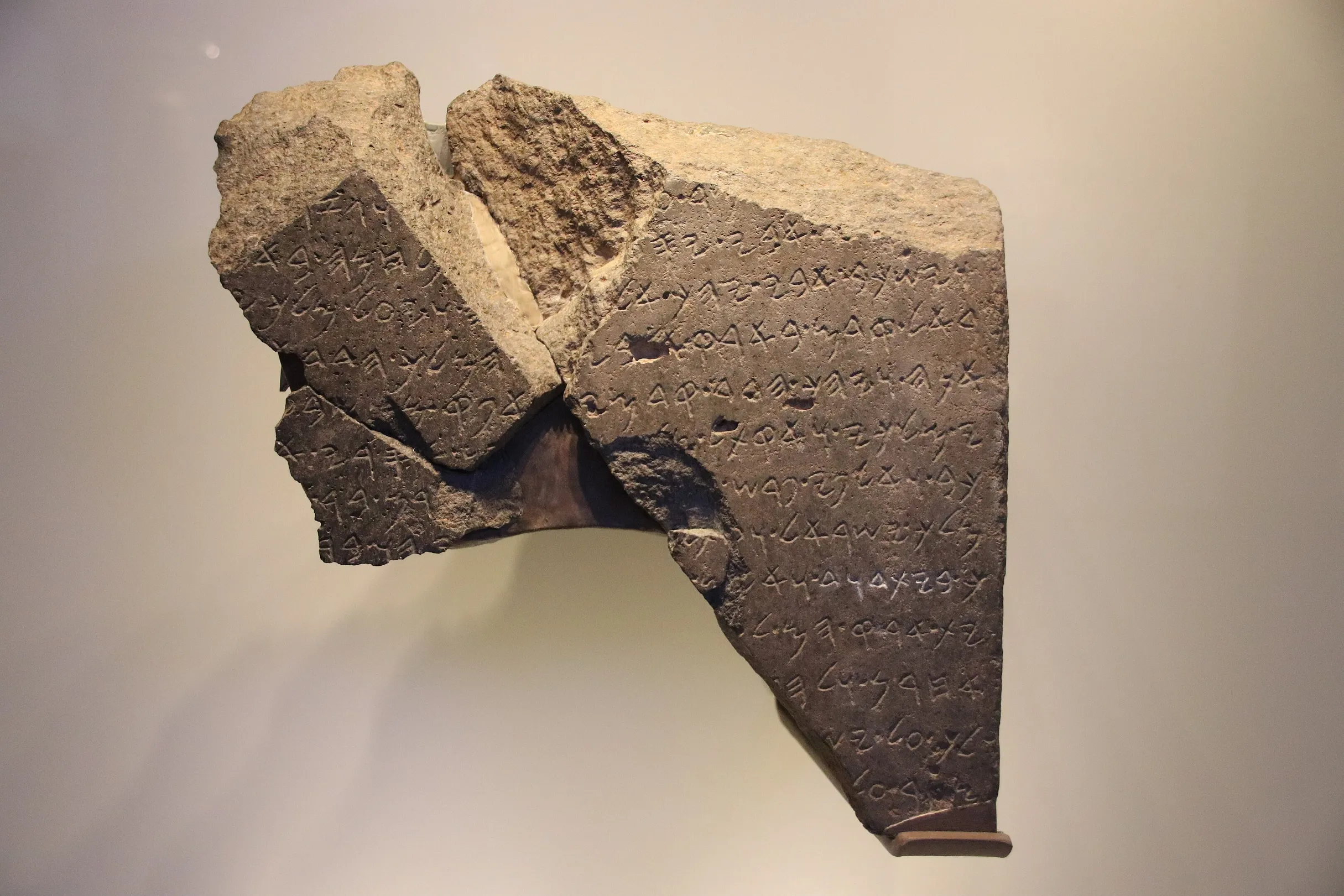
Biblical Archaeology Proves the Bible: How the Tel Dan Stele Silences Skeptics
Sunday, January 26, 2025Have you ever been in a conversation where someone casually dismissed the Bible as "just a bunch of old stories"? I've been there, and honestly, it used to make me feel a bit defensive. But here's the thing—biblical archaeology keeps proving that our faith isn't built on fairy tales. Every few years, archaeologists uncover another piece of ancient evidence that makes skeptics scratch their heads and believers smile.
From inscriptions carved in stone thousands of years ago that mention biblical kings by name, to pottery shards that confirm biblical cities actually existed, these discoveries offer real, tangible proof of the Bible's accuracy as a historical document. It's like finding your grandfather's war medals in the attic—suddenly, those family stories feel incredibly real.
This article digs into some of the most exciting archaeological finds—especially the jaw-dropping Tel Dan Stele—that provide solid historical evidence for the Bible. We'll explore how these archaeological discoveries that prove the Bible give us confident answers when skeptics challenge our faith. The beautiful truth is that Christianity doesn't ask us to close our eyes and just believe—it invites us to examine the evidence.
The Tel Dan Stele: A Game-Changing Discovery
What Is the Tel Dan Stele?
Picture this: you're an archaeologist working in the hot Israeli sun at Tel Dan, carefully brushing dirt off ancient stones. Then suddenly, you uncover something that changes everything. That's exactly what happened in 1993-1994 when researchers discovered what we now call the Tel Dan Stele—one of the most significant biblical archaeology finds of our lifetime.
This isn't just any old rock. It's a basalt stone inscription dating back to around 841-840 BC, erected by an Aramean king (most likely Hazael of Damascus) who was essentially bragging about his military victories over Israel and Judah. Think of it as an ancient version of a victory tweet, carved in stone for all eternity.
But here's what made archaeologists practically jump out of their boots: the inscription explicitly mentions the "House of David" (bytdwd in Hebrew). This was the first time anyone had found David's name outside the Bible itself. For years, skeptical scholars had been claiming that King David was just a legendary figure—like King Arthur or something. But this stone tablet, carved by Israel's enemies no less, proves that David's royal dynasty was so well-known and established that even foreign kings acknowledged it.
Historical Context and Biblical Correlation
When I first learned about this discovery, it reminded me of finding an old newspaper clipping that confirms a family story your grandmother always told. The Tel Dan Stele perfectly matches up with the biblical account in 2 Kings 8-10, which describes all the political drama and warfare between Israel, Judah, and Aram-Damascus during the 9th century BC.
The inscription mentions killing the kings of Israel and Judah, which lines up beautifully with what Scripture tells us about the deaths of Jehoram of Israel and Ahaziah of Judah (2 Kings 9:24, 27). It's like having two witnesses to the same car accident—their stories match because they're both telling the truth.
This discovery shows us something profound: the biblical writers weren't sitting around making up stories. They were accurately recording real political events, international conflicts, and dynastic histories that archaeology now confirms through completely independent sources.
Additional Archaeological Validations of Biblical History
The Merneptah Stele and Early Israel
 Let me tell you about another incredible find that gives me goosebumps every time I think about it. The Merneptah Stele, dating back to around 1208 BC, contains the earliest known reference to "Israel" outside the Bible.
An Egyptian pharaoh was so bothered by this people group called
"Israel" that he carved their name in stone while bragging about
defeating them.
Let me tell you about another incredible find that gives me goosebumps every time I think about it. The Merneptah Stele, dating back to around 1208 BC, contains the earliest known reference to "Israel" outside the Bible.
An Egyptian pharaoh was so bothered by this people group called
"Israel" that he carved their name in stone while bragging about
defeating them.
What's amazing is that this confirms the biblical timeline—Israel was already established as a distinct people in Canaan exactly when the Bible says they were, during the period we read about in Judges. It's like finding your great-grandfather's name in an old city directory, proving he really did live where your family always said he did.
Key biblical connections:
- Validates Israel's existence during the period described in Judges
- Confirms Israel's settlement in Canaan as described in Joshua
- Provides external verification of Israel as a distinct people group
The Cyrus Cylinder and Biblical Prophecy
 Now this one really blows my mind. The Cyrus Cylinder from 539 BC reads like it could have been copied straight from the book of Ezra.
This clay cylinder describes how Cyrus the Great made a decree allowing
exiled peoples to return to their homelands and rebuild their
temples—exactly what Ezra 1:1-4 and 2 Chronicles 36:22-23 tell us
happened to the Jewish exiles.
Now this one really blows my mind. The Cyrus Cylinder from 539 BC reads like it could have been copied straight from the book of Ezra.
This clay cylinder describes how Cyrus the Great made a decree allowing
exiled peoples to return to their homelands and rebuild their
temples—exactly what Ezra 1:1-4 and 2 Chronicles 36:22-23 tell us
happened to the Jewish exiles.
But here's the kicker: Isaiah prophesied about Cyrus by name nearly 200 years before he was even born (Isaiah 44:28; 45:1). Imagine if someone in 1825 had written a detailed prophecy about a specific leader who would emerge in 2025, mentioning them by name and describing exactly what they would do. That's essentially what we're looking at here.
Pontius Pilate Inscription

It's like finding an old business card that proves someone your family always talked about really did have the job they claimed to have. The New Testament writers got their facts straight, down to the specific governmental details.
Addressing Archaeological Challenges and Limitations
What Archaeology Can and Cannot Prove
Now, I want to be honest with you about something important. While biblical archaeology gives us fantastic proof of the Bible's historical framework, we need to understand what it can and can't do. Think of archaeology like a really good detective—it's excellent at establishing the facts, but it can't tell us everything.
Archaeology is amazing at validating:
- Historical settings and contexts
- Political structures and international relations
- Cultural practices and customs
- Existence of biblical figures and places
But archaeology can't verify:
- Supernatural events or miracles
- Personal conversations or private encounters
- Specific theological claims
- Individual faith experiences
And you know what? That's perfectly okay. As Hebrews 11:1 reminds us, "Now faith is confidence in what we hope for and assurance about what we do not see." Archaeological evidence doesn't replace faith—it gives faith a solid foundation to stand on, like building a house on bedrock instead of sand.
Responding to Skeptical Arguments
I've heard skeptics say, "Well, if you can't find archaeological evidence for something in the Bible, then it probably didn't happen." But that's like saying your great-grandmother didn't exist because you can't find her diary. Here's why that argument doesn't hold water:
Archaeological discoveries keep surprising us. That Tel Dan Stele sat buried for almost 3,000 years before someone found it. Who knows what else is still out there, waiting to be discovered? Every year brings new finds that confirm biblical accounts.
Not everything survives 3,000 years. Think about it—if your house burned down today, what would archaeologists find 3,000 years from now? Probably some pottery, maybe some metal objects, but your family photos, important documents, and wooden furniture would be long gone. Ancient organic materials, papyrus scrolls, and wooden structures rarely survive in Mediterranean climates.
We're looking at ancient VIP records. Stone inscriptions and fancy pottery were expensive—they were the ancient equivalent of official government documents and luxury items. Regular people's everyday stuff didn't get the same preservation treatment, which means we're seeing history from a particular angle.
The Broader Impact of Archaeological Validation
Strengthening Historical Reliability
When I look at all these archaeological discoveries that prove the Bible, three things become crystal clear:
- Biblical writers had incredible memories for detail. They got the historical facts, political situations, and cultural contexts right across centuries of history. That's not the hallmark of people making things up—that's the sign of careful record-keeping and faithful transmission of truth.
- The message stayed consistent. When archaeological findings match biblical accounts so closely, it tells us these stories were preserved accurately from generation to generation. It's like that game of telephone, except the message actually stayed the same.
- If they got the checkable facts right, we can trust them on the bigger picture. When someone consistently tells you the truth about things you can verify, you start trusting them about things you can't verify too.
Building Bridges with Skeptics
Here's something I love about biblical archaeology and Bible accuracy—it gives us common ground with skeptics. When we can point to objective, scientific evidence, it shows that:
- We welcome investigation and questions
- Christianity isn't afraid of scholarship and historical inquiry
- Faith and reason actually work together beautifully
As Jesus said, "I am the way and the truth and the life" (John 14:6). Archaeological evidence reinforces that our faith is grounded in actual history, not wishful thinking or blind hope.
Biblical Foundation for Archaeological Validation
Scripture's Own Claims About Truth
What I find fascinating is that the Bible itself invites this kind of investigation. Luke didn't just wake up one morning and decide to write a Gospel—he tells us he "carefully investigated everything from the beginning" (Luke 1:1-4). Peter emphasizes that Christian faith isn't based on "cleverly devised stories" but on actual eyewitness testimony (2 Peter 1:16).
The Bible consistently teaches us that:
- Truth matters: "Buy the truth and do not sell it—wisdom, instruction and insight as well" (Proverbs 23:23)
- Evidence supports faith: "Always be prepared to give an answer to everyone who asks you to give the reason for the hope that you have" (1 Peter 3:15)
- God works through history: "Remember the former things, those of long ago; I am God, and there is no other" (Isaiah 46:9)
Archaeological Evidence as God's Providence
I can't help but see God's hand in the timing of these discoveries. Just when biblical reliability faces its biggest scholarly challenges, amazing finds like the Tel Dan Stele emerge from the ground. It's like God saying, "You want evidence? Here you go."
Conclusion
The Tel Dan Stele and countless other archaeological discoveries provide compelling historical evidence for the Bible's accuracy and reliability. They don't eliminate the need for faith—and honestly, I wouldn't want them to. But they show us that Christian belief stands on solid historical ground, not shifting sand.
Biblical archaeology keeps revealing that Scripture accurately preserved ancient history, political relationships, and cultural contexts across thousands of years. From David's dynasty to Pilate's courthouse, archaeological evidence consistently validates biblical accounts that skeptics used to dismiss as made-up stories.
As believers, these discoveries should strengthen our confidence that the same God who preserved historical details with such accuracy also faithfully preserved spiritual truths. For our skeptical friends, they provide objective evidence that the Bible deserves serious consideration as a historical document, not dismissal as ancient mythology.
The best part? We're probably not done yet. As archaeologists continue uncovering the ancient world, I expect we'll see even more validation of Scripture's historical reliability—just as Jesus promised: "Heaven and earth will pass away, but my words will never pass away" (Matthew 24:35).
More Articles
Comments



